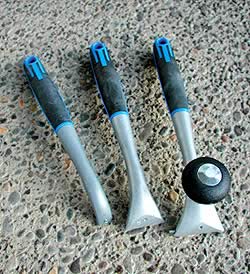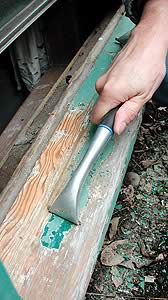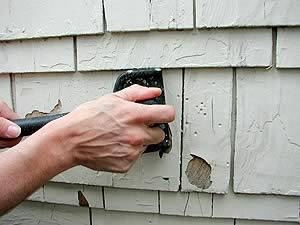
Paint Scrapers
Paint scrapers are useful in multiple situations, from shaving dry paint-runs off newly painted surfaces to planing excess paint and wood off doors and window openings and re-shaping details in existing wood trim.
by Bent Mikkelsen
are a tool that painters should have with them on virtually every painting project. They may seem of little use on new construction projects, but they will show their muscle on every job site at one time or another. Even though the common solution nowadays is to replace older building materials with new materials — rather than refurbishing — scraping tools can often remedy a problem surface faster than a phone call to the local hardware store.
Scrapers are useful in multiple situations, from shaving dry paint-runs off newly painted surfaces to planing excess paint and wood off doors and window openings and re-shaping details in existing wood trim. They’re also handy for removing large amounts of built-up paint from wood, metal or masonry sidings and for removing noticeable lines where areas of old paint have been removed from the substrates after pressure washing or chemical stripping. Scrapers are a tool few painters seem willing to utilize or keep on hand, but when used appropriately they can help uncover problem areas and transform blistered coatings and damaged surfaces into the next best thing to new.  Scrapers come in various styles and shapes, each offering specific advantages. Blade widths, which vary from one to six inches, are designed for achieving productivity on many types of surfaces. Scraper handles also vary in size, with larger handles allowing you to use more pressure and smaller handles making it easy to get into tight spots, such as window trim or moldings, that require meticulous work. Scrapers come in various styles and shapes, each offering specific advantages. Blade widths, which vary from one to six inches, are designed for achieving productivity on many types of surfaces. Scraper handles also vary in size, with larger handles allowing you to use more pressure and smaller handles making it easy to get into tight spots, such as window trim or moldings, that require meticulous work. Having started my apprenticeship in the painting trade with a scraper and sandpaper in hand, I grew accustomed to making sure I had scrapers of all sizes and shapes carefully stowed in my tool box at all times. As you are probably aware, there are two types of scrapers: steel blade or carbide blade. Steel-blade scrapers, which are generally less expensive, provide a valuable function in general paint scraping applications. Although steel blades will become dull quickly, they are easily sharpened with a file on the job site whenever necessary. Carbide-blade scrapers are a tool most experienced painters don’t like to lend out. They are more expensive to purchase but they offer obvious advantages. Because they are extremely sharp and straight, they will accomplish more with less effort. With carbide blade scrapers, articulating the angle of your scraper handle will change the level of impact on surfaces to be scraped. This attribute translates into a greater variety of uses for a broader range of scraping applications.  Because carbide blades maintain such a sharp and straight edge, they can be used for other types of repairs as well. In photo one, the carbide scraper is used to remove deep scratches and door dings from an existing wood door prior to re-staining and finishing. Because carbide blades maintain such a sharp and straight edge, they can be used for other types of repairs as well. In photo one, the carbide scraper is used to remove deep scratches and door dings from an existing wood door prior to re-staining and finishing. It should be noted that carbide blades are susceptible to damage just like a carbide blade on an electric hand-held or table saw. Continued use on surfaces with protruding nail heads can lead to damage from chipping or pitting of the carbide blade. This can be avoided by switching to a steel-blade scraper whenever these protrusions are encountered.
Just like any other tool, if your scrapers are properly cared for and maintained they will provide years of useful service.
Deriving the most benefit from any scraper comes from maintaining a sharp blade. Steel blades are easily sharpened on the job site with a fine-tooth file. As shown in photo two, a sharp edge is maintained by angling the file at 45 degrees and drawing down and across the blade simultaneously. Do not change the direction of your file but rather repeat this sequence continuously until the blade is sharp. You are then ready to resume scraping applications. A carbide blade is best sharpened by a professional blade sharpening company. Carbide blades will generally require sharpening once a year and cost very little to have sharpened. Keeping them professionally maintained will offer noticeable advantages and keep them in top working order at all times.
Scrapers are best protected by storing them in a leather sheath or rolled separately in a leather skin. Leather keeps the blades from coming in contact with each other and with other tools in your tool box. If your scrapers are going to be used correctly and professionally for any of the applications we have discussed, be sure they are kept in top condition at all times. 
|

